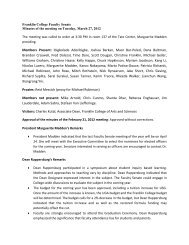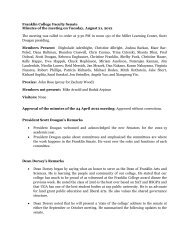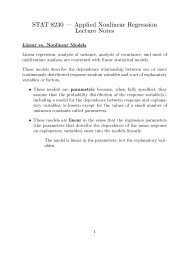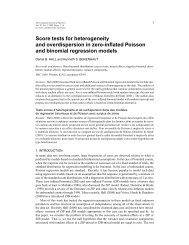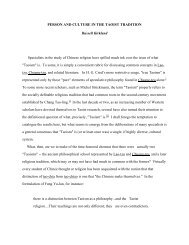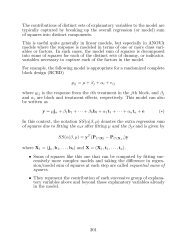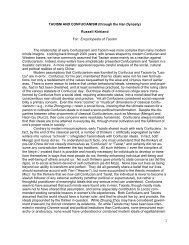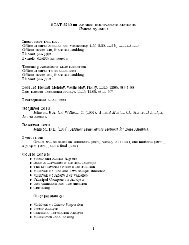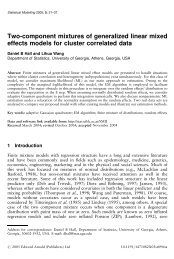Robust Estimation for Zero-Inflated Poisson Regression - Franklin ...
Robust Estimation for Zero-Inflated Poisson Regression - Franklin ...
Robust Estimation for Zero-Inflated Poisson Regression - Franklin ...
You also want an ePaper? Increase the reach of your titles
YUMPU automatically turns print PDFs into web optimized ePapers that Google loves.
2 D. B. Hall and J. Shen Scand J Statistwhere B T i and G T i are the ith rows of design matrices B and G. Although this log-likelihoodcan be maximized directly, a particularly convenient method to obtain the maximumlikelihood estimator (MLE) is to capitalize on the mixture structure of the problem and usethe EM algorithm.Hall (2000) extended Lambert’s model and methodology to an upper bounded countsituation, thereby obtaining a zero-inflated binomial (ZIB) regression model. Another popularmodel is the zero-inflated negative binomial (ZINB) regression model, which is definedsimilarly by swapping the negative binomial distribution instead of the <strong>Poisson</strong> componentin a ZIP model. Although the focus of this paper is to develop robust estimation <strong>for</strong>ZIP regression models, the methods can be extended to other ZI models in the samemanner.In mixture models and more generally, the robustness of the MLE has been studied extensively.It is well known that the MLE can be unstable when the data have contaminationpoints. In this paper, we propose an alternative approach, which we term robust expectationsolution(RES) estimation, and which is related to M-estimation. Huber (1964) proposedM-estimation as a generalization of ML in which the score function in the likelihoodequation is replaced by an estimating function, which is typically chosen to downweight thecontributions of extreme observations. Recently, several authors have extended M-estimationto the GLM context <strong>for</strong> independent observations (Cantoni & Ronchetti, 2001; Adimari &Ventura, 2001) and <strong>for</strong> the clustered/longitudinal data setting (Preisser & Qaqish, 1999;Cantoni, 2004). In GLM, M-estimation typically proceeds by solving estimating equations inwhich the contributions of observations with large Pearson residuals are reduced by downweighting.In a mixture context, however, this approach has obvious drawbacks. For example,in a 50:50 mixture of well-separated components, all observations are far from the overallmean and will necessarily have large Pearson residuals that should not be downweighted in<strong>for</strong>ming an overall estimation criterion. In this paper, we get around this problem by applyingM-estimation to the M-step of an EM algorithm (or, to be precise, an expectation-solutionor ES algorithm). Roughly speaking, this approach effectively imputes which component eachobservation comes from, and then downweights the contributions of observations that areextreme in terms of low probability relative to the component to which they belong.Recently, Lu et al. (2003) proposed a minimum Hellinger distance (MHD) approach <strong>for</strong>finite mixtures of <strong>Poisson</strong> regression models, a class of models in which the ZIP model falls.These authors present simulation results that suggest that their approach per<strong>for</strong>ms very wellrelative to ML in the presence of outliers and/or poor separation between the mixturecomponents. As we will see, however, this approach has a limited domain of applicationbecause of identifiability problems that can arise when the mixing probability depends uponcovariates, which is typical in applications of ZI regression. In addition, MHD approachesare not particularly effective <strong>for</strong> mixture models when the components are well separated.Furthermore, the asymptotics of MHD estimation in the regression context are difficult toestablish. There<strong>for</strong>e, we propose the RES approach and include MHD estimation as astandard of comparison.The organization of this paper is as follows. Section 2 introduces the RES methodologyand discusses its robustness and efficiency properties. Section 3 describes MHD estimation<strong>for</strong> ZIP models and addresses the identifiability problem that arises with this approach. Simulationresults are presented in section 4 to compare these two methods with ML estimation.To illustrate the methodology, section 5 discusses the modelling of data from an investigationof factors predictive of youth involvement in ‘use of <strong>for</strong>ce’ (UOF) incidents during detentionin Georgia state facilities. Finally, some discussion and concluding remarks are provided insection 6.© 2009 Board of the Foundation of the Scandinavian Journal of Statistics.



